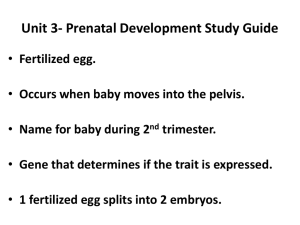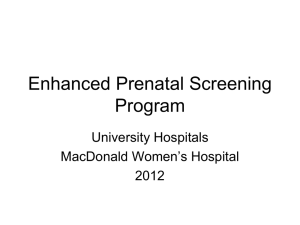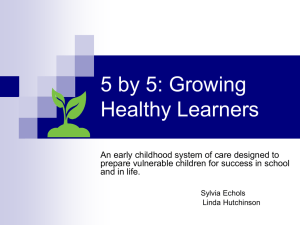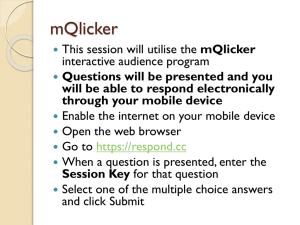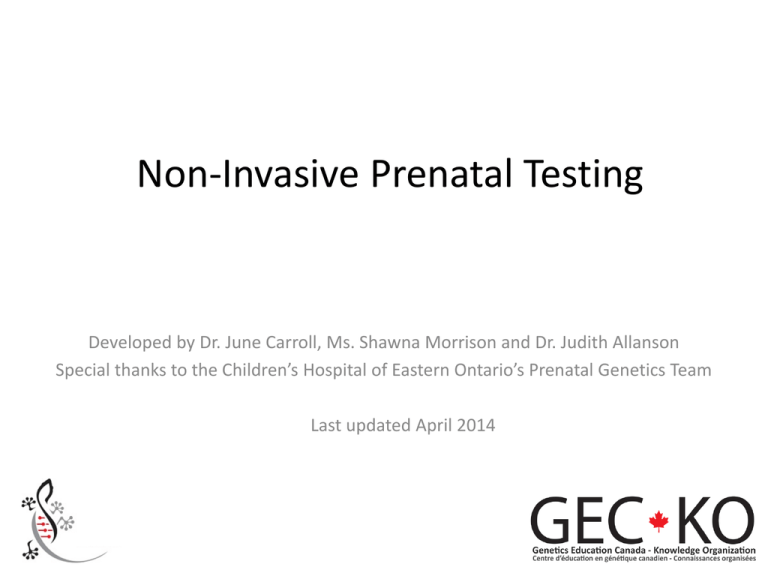
Non-Invasive Prenatal Testing
Developed by Dr. June Carroll, Ms. Shawna Morrison and Dr. Judith Allanson
Special thanks to the Children’s Hospital of Eastern Ontario’s Prenatal Genetics Team
Last updated April 2014
Disclaimer
• This presentation is for educational purposes only and should
not be used as a substitute for clinical judgement. GEC-KO
aims to aid the practicing clinician by providing informed
opinions regarding genetic services that have been developed
in a rigorous and evidence-based manner. Physicians must use
their own clinical judgement in addition to published articles
and the information presented herein. GEC-KO assumes no
responsibility or liability resulting from the use of information
contained herein.
Objectives
• Following this session the learner will be able to:
― Refer to their local genetics centre and/or order genetic
testing appropriately for prenatal screening
― Discuss and address patient concerns regarding prenatal
screening
― Facilitate patient informed decision making regarding
prenatal screening options
― Find high quality genomics educational resources
appropriate for primary care
Case 1
A 32 year old woman has had a positive
Integrated Prenatal Screening Test (IPS) result
for Down syndrome. She is about 17 weeks
gestation.
― Is NIPT a good option?
Case 2
A 40 year old G1 woman is about 9 weeks
gestation. She is in your office to discuss
prenatal testing options in this pregnancy
conceived by IVF.
―Is NIPT a good option?
Case 3
• A 36 year old G1P0 woman is very anxious
about Down syndrome in this pregnancy
because she had a second cousin with Down
syndrome who passed away as a child.
― Is NIPT a good option?
Case 4
• A 29 year old patient had a nuchal
translucency (NT) of 4.4mm at 12+5 weeks
gestation
• You offered NIPT and she accepted
• NIPT results were normal. She is now 14+2
weeks gestation
• What are the next steps?
Prenatal Screening tests for:
DS, T18, T13 and ONTD
Screening Test
Markers
Trimester
Term Risk Cut
Off
DR (%)
FPR(%)
FTS
NT, PAPP-A,
f-BhCG/total
hCG , MA
1st
1/350
85*
5.4*
IPS
NT, PAPP-A,
AFP, uE3,
f-BhCG / total
hCG, MA
1 &2
1/200
85.5**
2.5**
Quadruple
Screen
AFP, uE3,
total hCG, MA
2
1/200
82.5*
5.6*
Serum
Integrated
Screen
PAPP-A, f-BhCG
/ total hCG, AFP,
uE3, inhibinA,
MA
1 &2
1/200
Insufficient data
3.3%
st
nd
nd
st
nd
†
*Estimation based on data from NYGH and MSH screening laboratories. Note there is not complete ascertainment of false
negatives
** Estimation based on data from NYGH (Jan 2003-Jun 2011)
†
Total positive rate for SIPS from all Ontario labs. This is an estimate for the FPR given the small volume of uptake on this
particular screen test.
NIPT
Cell free DNA
st
nd
1 or 2
n/a
>99%
<0.1%
What is Non-Invasive Prenatal Testing?
• Screening test to prenatally detect Down
syndrome and other aneuploidies (extra or
missing chromosomes)
― trisomy 21, 18, 13
― trisomy of sex chromosomes (XXX, XXY, XYY)
― Turner syndrome (monosomy X)
― triploidy (extra copy of all chromosomes)
Non-Invasive Prenatal Testing (NIPT)
• NIPT measures circulating cell-free DNA (cfDNA) from
placenta present in maternal blood
• Comprises ~10% of DNA in maternal blood
• Increases with gestational age
• Companies offering NIPT use various technologies to
analyze cfDNA and determine chromosome quantities
• Performed on maternal blood sample
• As early as 9 weeks gestation (company specific)
• Dating U/S – viability, accurate GA, exclude multiples
How good is Non-Invasive Prenatal Testing?
• Moving target
• Currently literature is primarily from companies or those
holding patents
Overall ranges
T21
T18
T13
Specificity (%)
99-100
99-100
99-100
Sensitivity (%)
98-100
97-100
79-100
Positive Predictive
Value [PPV] (%)
90-95*
84*
52*
Negative Predictive
Value [NPV] (%)
99.9
99
100
*ASHG Oct 2013 platform presentation – data from BGI China;
63,543 pregnancies
What is the evidence for Non-Invasive
Prenatal Testing (NIPT)?
• Studies emerging in low-risk population
• Performance of NIPT in a general obstetrical
population
―False Positive Rate (FPR) for T21 and T18 combined was
0.5% vs 4.2% for standard screening
―Positive Predictive Value (PPV) was significantly higher
than that for standard screening, for both trisomy 21
(45.5% vs. 4.2%) and trisomy 18 (40.0% vs. 8.3%)
Bianchi et al, NEJM 2014; 370:9
What is the evidence for Non-Invasive
Prenatal Testing (NIPT)?
• 7 studies of “high risk” women
• High risk:
―Screen (IPS, FTS) positive
―AMA (≥35 yrs)
―Ultrasound findings suggestive of aneuploidy
―Previous pregnancy with aneuploidy
What is the evidence for Non-Invasive
Prenatal Testing (NIPT)?
• By far most accurate performance for T21/18
Benn et al, Ultras Obstet Gynecol 2013, 42: 15-33
What do the experts say?
• Society of Obstetricians & Gynecologists of
Canada 2013
― Non-invasive prenatal testing using massive
parallel sequencing of cell-free DNA to test for
trisomies 21, 18, and 13 should be an option
available to women at increased risk in lieu of
amniocentesis. Pre-test counselling of these
women should include a discussion of the
limitations of non-invasive prenatal testing.
Genetics Ctte Technical Update JOGC: Feb 2013
What do the experts say?
• Society of Obstetricians & Gynecologists of
Canada 2013
― No irrevocable obstetrical decision should be
made in pregnancies with a positive non-invasive
prenatal testing result without confirmatory
invasive diagnostic testing.
Genetics Ctte Technical Update JOGC: Feb 2013
Recommendations
• Offer all women:
― Prenatal screening using either FTS, IPS or
MSS (SIPS or Quad)
― Fetal morphology scan at 18-20 weeks’
gestation
Consider discussing Non-Invasive Prenatal
Testing (NIPT) as an option for women who:
Are of advanced maternal age , defined as 40 years of age or older at
estimated date of birth
Have an abnormal multiple marker screen i.e. FTS/IPS/MSS
Have fetal nuchal translucency (NT) measurement of 3.5mm or greater
Have had a previous pregnancy or child with aneuploidy
Have other high risk factors:
Fetal congenital anomalies on ultrasound highly suggestive of trisomy 13, 18 or
21*
Soft markers on ultrasound which are highly suggestive of aneuploidy [Refer to
SOGC guidelines, 2005].*
At risk of carrying a male fetus with an X-linked condition (NIPT would be used
for sex determination)*
In Ontario, MOHLTC funding applications for the indications above marked by an asterisk (*) must be
submitted by a geneticist or maternal fetal medicine (MFM) specialist. In other provinces
circumstances may be different. Consult your local genetics centre or MFM specialist.
Non-Invasive Prenatal Testing (NIPT) results
• Results will be reported differently and may
be worded as:
― positive or negative
― aneuploidy detected, no aneuploidy detected or
aneuploidy suspected/borderline value
― high risk or low risk
Non-Invasive Prenatal Testing (NIPT) results
• If the result is negative, this is reassuring
• Your patient should still be offered:
― MS-AFP between 15 and 20+6/7 weeks to screen for open
neural tube defect, as NIPT does not screen for this
physical anomaly
― fetal morphology scan at 18-20 weeks’ gestation
― referral for genetic and/or maternal fetal medicine
consultation, which may be indicated for additional
counselling and testing, depending on the reason your
patient qualified for NIPT (e.g. increased NT, other soft
markers, congenital anomalies)
Non-Invasive Prenatal Testing (NIPT) results
• If the result is positive:
― Genetic counselling
― Confirmation by diagnostic testing
No irrevocable obstetrical decisions should be
made in pregnancies with abnormal NIPT
results without confirmatory invasive testing
(CVS or amniocentesis) - SOGC
Benefits of Non-Invasive Prenatal
Testing (NIPT)
• Fewer women having diagnostic tests with
associated risk of pregnancy loss
• Early test result (drawn at ≥ 9-10 weeks at earliest)
• No risk of miscarriage
• Detects the most common chromosomal
aneuploidies
• Higher detection rates and lower false positive
rates than IPS or MSS
Limitations of Non-Invasive Prenatal
Testing (NIPT)
• NIPT cannot:
― Detect chromosome differences other than aneuploidy of
chromosomes 13, 18, 21, X and Y
•
some companies are now adding screening for other trisomies and certain
microdeletion syndromes
― Completely rule out aneuploidy
― Detect single gene conditions
― Detect congenital anomalies
• Failed results
― 6.1% untested for insufficient sample quality
― 2% no result after testing (rarely happens with conventional screening)
• cfDNA decreases with increased maternal BMI, twin
pregnancies and where trisomy 18 and 13 are present
• Limited data on performance in IVF pregnancies
Limitations of Non-Invasive Prenatal
Testing: Confined placental mosaicism
• False positives (and negatives) are possible
―Confined placental mosaicism
Non-Invasive Prenatal Testing (NIPT) Landscape
•
•
•
•
•
•
Increasing demand from women
Increasing uptake in most (urban) centres
3 separate companies, 3 separate technologies
Has NIPT become “standard of care”?
Costs between $795 and $1200
8-10 days for result
Where does Non-Invasive Prenatal Testing (NIPT)
fit with respect to the 11 to 14 wk scan?
• 11 to 14 week scan has value to pregnancy care
― Raised NT may suggest other chromosomal, genetic
and structural disorders
― Accurate dating/establishment of live fetus
― Multiples/chorionicity affects management
― Detects structural abnormalities
Non-Invasive Prenatal Testing (NIPT) and
counselling
•
•
•
•
Pre- and post-test counselling is important
Consult genetics if unsure
Refer for genetic counselling when appropriate
Company websites:
―Harmony Prenatal Test™ by Ariosa Diagnostics through
Gamma-Dynacare
―Panorama™ by Natera through Lifelabs
―Verifi® Prenatal Test by Verinata
Ordering Non-Invasive Prenatal Testing
(NIPT)
• In Ontario, to order NIPT, first determine your patient’s funding eligibility
by looking at the MOHLTC checklist, then:
• Complete the checklist and pages 2 and 4 of the MOHLTC out-of-country
testing prior approval form
• Download and complete the requisition from the NIPT company of your
and your patient’s choice
― Selection may be based on the patient’s personal research and preference,
your experience with a particular company, ease of access to a blood draw
location
• Send all three completed forms to the fax number 613 536-3181 or 1 866
221-3536 and be sure to indicate the patient is pregnant so approval can
be prioritized accordingly
• Once approval has been received, give the patient the approval letter and
the NIPT requisition and she can then have her blood drawn
Case 1
A 36 year old woman has had a positive
Integrated Prenatal Screening Test (IPS) result
for Down syndrome. She is about 17 weeks
gestation.
― Is NIPT a good option?
• Yes
―She is eligible for NIPT with MOH funding
• But consider:
― More rapid result from amniocentesis
― What is her IPS risk?
• 1 in 2 versus 1 in 120
― She is at 17 weeks gestational age
• If NIPT is positive, guidelines recommend confirmatory diagnostic
testing by amniocentesis – delays timing for diagnosis
―In the event of an abnormal result, is termination of
pregnancy an option for the couple?
Case 2
A 40 year old G1 woman is about 9 weeks
gestation. She is in your office to discuss
prenatal testing options in this pregnancy
conceived by IVF.
―Is NIPT a good option?
• Yes
― Advanced maternal age (greater than 40 years at
EDB) is an appropriate indication for NIPT
― Covered by MOH funding
― Better screen than IPS
― Earlier result
― Decreased chance with NIPT that patient would
receive screen positive result
Case 3
• A 36 year old G1P0 woman is very anxious
about Down syndrome in this pregnancy
because she had a second cousin with Down
syndrome who passed away as a child.
― Is NIPT a good option?
Case 3
• She does not meet MOH criteria for
coverage of NIPT
• You can reassure her that having a second
cousin with Down syndrome does not
increase her risk to have an affected child
• If she is very anxious, you can proceed
with NIPT and she can pay out of pocket
• If the patient herself had a previous affected pregnancy
then she would be eligible for MOH funded NIPT
1a
1b
2a
2b
3a
3b
4a
4b
P
Case 4
• A 29 year old patient had an NT of 4.4mm at
12+5 weeks gestation
• You offered NIPT and she accepted
• NIPT results were normal. She is now 14+2
weeks gestation
• What are the next steps?
• Genetic counselling is recommended
• Patient likely to be offered:
―
―
―
―
Chromosomal microarray
Genetic testing for other single gene conditions
Level II ultrasound
Fetal echocardiogram
Prenatal Screening Summary
• Offer all pregnant women, regardless of age:
― PN screening for fetal aneuploidy (trisomy 13, 18, 21) through FTS, IPS, SIPS or
Quad screening
― Second trimester ultrasound for dating, assessment of fetal anatomy and
detection of multiples
• Maternal age should not be used as a basis for recommending invasive
testing when non-invasive PN screening is available
• Non-Invasive Prenatal Testing (NIPT)
― Consider offering NIPT to high risk women
― Consider NIPT as a screen of higher sensitivity if your patient is willing to
pay for the test
― Best for Down syndrome (trisomy 21) (but can be wrong!)
• so far, others not as good (T13 and sex chromosomes)
― Effectively sampling the placenta (not fetal cells directly)
― It is not a diagnostic test
― Not an all purpose genetic test, only gives info on specific chromosomes,
and so not indicated in all circumstances
Don’t forget
• Take a family history to identify familial and/or
ethnicity-specific disorders and screen
accordingly
• Consider consanguinity and screen and test
accordingly
• Refer or consult genetics when in doubt
Useful Genetics Resources
• GEC-KO website: Genetics Education
www.geneticseducation.ca
• NIPT fact sheets:
― http://www.mountsinai.on.ca/care/family-medicine-geneticsprogram/prenatal
• Prenatal Screening Ontario Website
― http://www.prenatalscreeningontario.ca/
• Society of Obstetricians and Gynaecologists of Canada (SOGC)
national clinical guidelines in prenatal genetics visit
http://sogc.org/clinical-practice-guidelines/ and scroll down to
Genetics.




